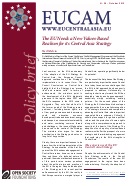The EU Education Initiative for Central Asia Five Years On: Lessons Learnt?
The EU Education Initiative for Central Asia Five Years On: Lessons Learnt?
Author(s): Vera Axyonova
Subject(s): Education, Governance, International relations/trade, State/Government and Education, Social development
Published by: CEPS Centre for European Policy Studies
Keywords: European Union; education initiative; Central Asia; development of education system; education sector; educational policies;
Summary/Abstract: Over the past 20 years, developments in Central Asia’s education system have been mixed. The private education sector has been growing, especially in Kazakhstan and Kyrgyzstan, with fully-equipped classrooms and the application of best teaching practices. In the public sector, however, the general trend continues to point to a lack of financial and human resources, insufficient access to up-to-date materials and modern infrastructure, the politicisation of education, and everincreasing corruption. The sporadic reforms initiated by Central Asian governments have sometimes even worsened the situation – Turkmenbashi’s regressive educational policies are the clearest example of this. Half of the region’s population is under 30 years of age, which means that about 25 million people are directly affected by the drastically degrading quality of education. If the European Union (EU) is serious about supporting educational reform in Central Asia, it needs to take local conditions into account when dealing with the challenges outlined above.
Series: EUCAM - Policy Brief
- Page Count: 5
- Publication Year: 2013
- Language: English
- Content File-PDF

